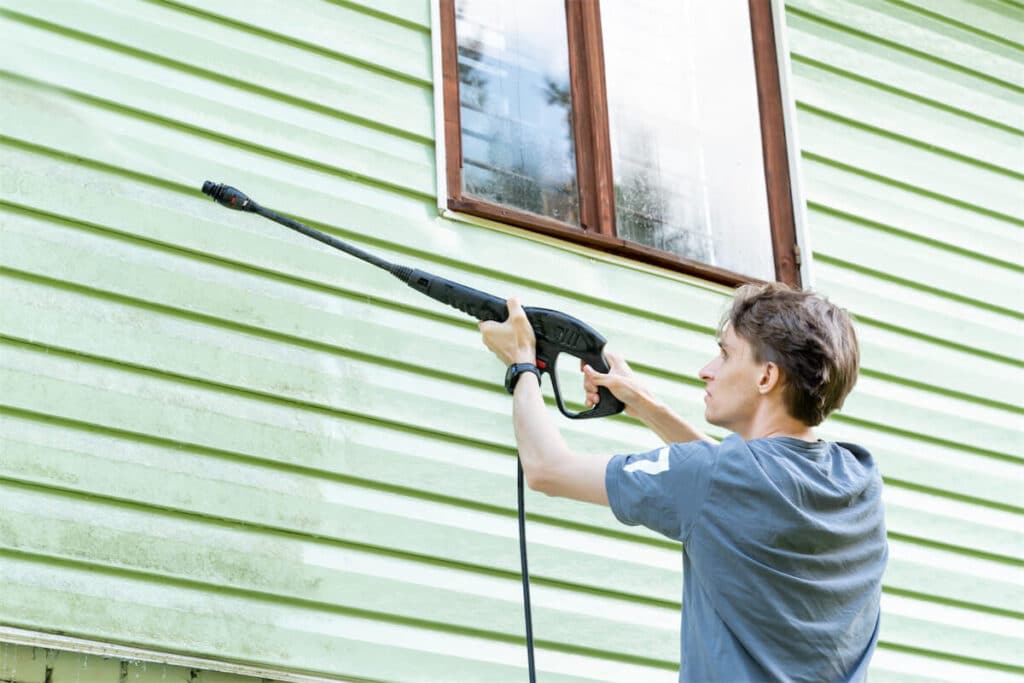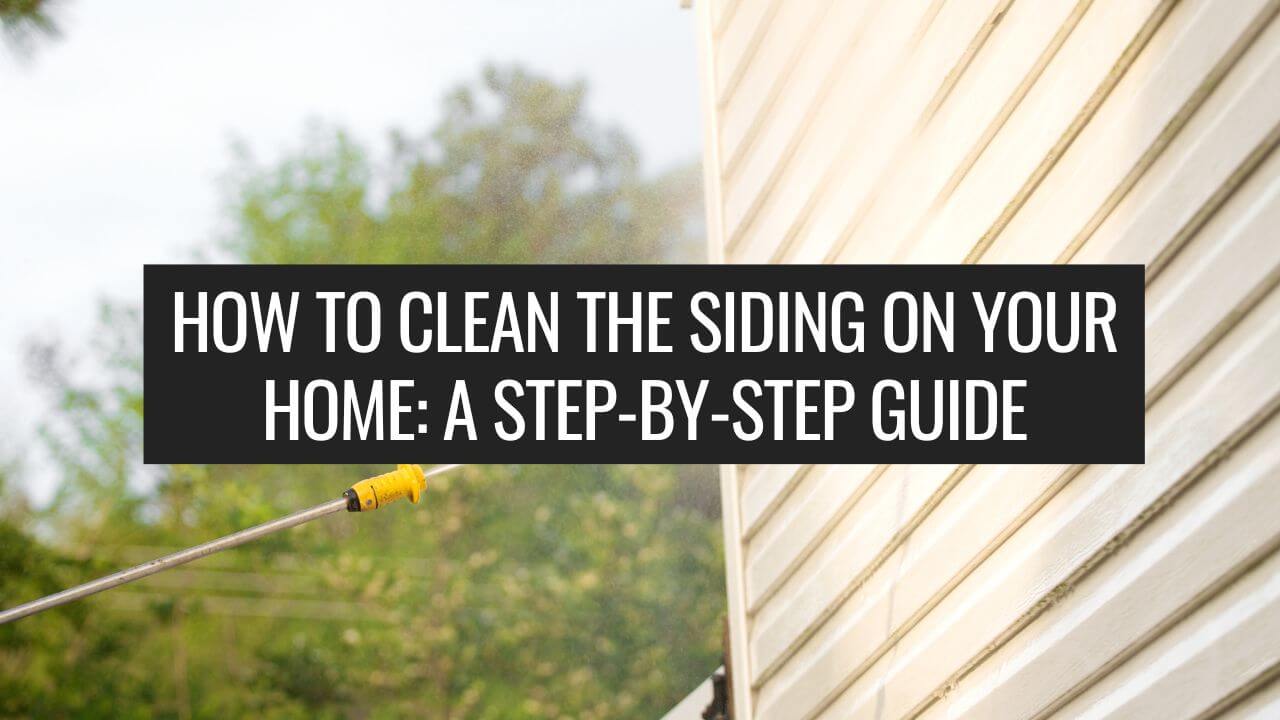One of the most important aspects of maintaining your home’s exterior is keeping the siding clean. Over time, dirt, mildew, and other contaminants can accumulate on your house’s siding, making it appear dingy and potentially causing damage.
In this article, we will discuss some steps and techniques to effectively clean the siding on your home, giving it a fresh, updated appearance while also prolonging its life.
Cleaning the siding on your home is essential for both aesthetic and practical reasons. A well-maintained exterior can increase your home’s overall curb appeal and help prevent any potential damage that can occur from build-up on the siding. We will cover various cleaning methods, including power washing, and using specific cleaning solutions that can be tailored to your siding’s unique requirements, ensuring a thorough and safe cleaning process.

Choose the Right Cleaning Method
There are various methods to clean the siding on your home, and selecting the correct one depends on its material and condition. Here are the most common cleaning methods:
- Soapy Water and Brush
- Pressure Washing
- Chemical Cleaning
Soapy water and a brush are a low-cost and easy option for vinyl, wood, and metal siding that is not too dirty. Start by mixing mild soap, like a dish detergent, with water. Gently scrub the siding with a soft-bristle brush, avoiding excessive pressure that could damage the surface.
For notably dirty or large areas, pressure washing may be more efficient. However, this method requires caution, as improper use can damage your siding or force water into your walls. To avoid this, choose a low-pressure washer setting, stand at least two feet away from the siding, and avoid spraying at an upward angle. Always follow the siding manufacturer’s guidelines if provided.
Chemical cleaning is ideal for stubborn stains, such as mold or mildew on various siding types. Select a cleaner specifically designed for your siding material and follow the instructions for mixing, application, and removal. Rinse the area thoroughly after chemical treatment to avoid discoloration or damage. Remember to wear gloves and protective eyewear when handling chemicals.
It is essential to test your chosen method on a small, inconspicuous area of your siding to ensure compatibility and prevent damage. This will help you determine which cleaning method works best for your specific situation.

Prepare Your Workspace
Before you begin cleaning your home’s siding, it’s essential to properly prepare your workspace. This will help ensure safety and efficiency throughout the process.
Here’s a list of steps to follow:
- Clear the area: Remove any obstacles, such as outdoor furniture, potted plants, and garden tools, from the area around your home. This will give you ample space to work and prevent any accidents or damage.
- Protect vegetation: If you have plants or shrubbery close to your house, gently cover them with plastic sheeting. This will protect them from potential damage caused by any cleaning agents you use.
- Turn off power: If you’re using an electric pressure washer, make sure the power is turned off before you start working. Additionally, ensure all electrical outlets, switches, and fixtures around your workspace are properly covered to prevent water damage.
- Gather your supplies: Have all your cleaning materials ready, including a ladder, pressure washer, cleaning solution, scrub brush, and safety gear such as gloves, goggles, and non-slip shoes.
Taking the time to create a safe and organized workspace will make the siding cleaning process smoother and more effective.
Cleaning Vinyl Siding
When cleaning vinyl siding, it is essential to select appropriate tools and cleaning solutions for effective results. Follow these steps to keep your vinyl siding looking new:
- Choose a mild cleaning solution, such as a mixture of water (70%) and white vinegar (30%), or a gentle dish soap mixed with water.
- Use a soft bristle brush or a soft cloth to avoid scratching the surface of the siding.
- Work in sections, starting at the bottom and slowly moving upwards to prevent streaking.
- Rinse the siding with clean water using a garden hose or a pressure washer set at a low setting.
For more stubborn stains, two common types of cleaners can be used:
| Type of Cleaner | Usage |
| Oxygen bleach solution | Effective for removing mildew, algae, and mold. Mix according to the product’s instructions and apply gently to the affected area. |
| Commercial vinyl siding cleaner | Designed specifically for vinyl siding, these cleaners can remove stubborn stains and grime. Follow the manufacturer’s instructions and make sure to rinse the siding after using the product. |
Always remember to check your vinyl siding manufacturer’s recommendations for cleaning tips and approved cleaning solutions. It is also essential to wear gloves and eye protection when using any cleaning solutions.

Cleaning Brick Siding
Brick siding is a durable and low-maintenance choice for home exteriors, but it still requires occasional cleaning to maintain its appearance. To clean brick siding effectively and safely, follow these steps:
- Inspect the bricks: Before starting, check for any damaged bricks, crumbling mortar, or other issues that may require repair. Address these concerns prior to cleaning.
- Prepare the area: Remove any obstructions, such as furniture or potted plants, and cover nearby plants with tarps to protect them from potential damage.
- Use a low-pressure hose or power washer: Gently rinse the brick with water to remove loose dirt and debris. Be sure to use a low-pressure setting to avoid damaging the brick or mortar.
After the initial rinsing, you can use a combination of cleaning solutions and tools to remove more stubborn dirt, grime, and stains. Some options include:
- Mild detergent: Mix a solution of mild detergent and water in a bucket. Apply the solution to the brick using a soft-bristled brush, scrubbing gently in a circular motion. Rinse thoroughly with water afterward.
- Vinegar solution: Combine equal parts water and white vinegar in a spray bottle. Spray the solution on the bricks and let it sit for a few minutes before scrubbing with a soft-bristled brush. Rinse the area with water to remove residue.
- Muriatic acid: For particularly stubborn stains, a diluted solution of muriatic acid can be used. Follow the manufacturer’s instructions for proper dilution, and always wear protective gear when working with this strong compound. Apply the solution with a brush, scrub as needed, and rinse thoroughly with water afterward.
Remember to work in small sections, and keep the surface wet during the cleaning process to prevent the cleaning solution from soaking into the brick. Allow the brick to air dry after cleaning is complete.

Cleaning Fiber Cement Siding
Fiber cement siding is a durable and low-maintenance material, but it still requires periodic cleaning to maintain its appearance. Here are some tips for effectively cleaning fiber cement siding:
1. Gather the necessary equipment:
- Soft-bristle brush or sponge
- Garden hose with a spray nozzle
- Bucket of soapy water (mild detergent)
- Ladder (if necessary)
2. Wet the siding: Start by spraying a section of the siding with water from the garden hose. Make sure to spray from top to bottom to prevent dirt from running onto clean areas.
3. Apply soapy water: Dip the soft-bristle brush or sponge into the bucket of soapy water and gently scrub the wet siding. Work in sections and always scrub in a downward motion to minimize streaking.
4. Rinse the siding: After scrubbing a section, rinse the siding thoroughly with the garden hose. Be sure to remove all soap residue to avoid leaving a film on the siding.
5. Allow to dry: Let the siding air-dry before moving on to the next section. Avoid prolonged exposure to moisture, as it can cause damage to the siding over time.
Remember to follow the manufacturer’s recommendations for cleaning and maintenance to keep your fiber cement siding in top condition.

Rinse Thoroughly and Inspect
After applying the cleaning solution and allowing it to sit for the recommended time, it’s crucial to rinse the siding thoroughly. Use a garden hose with a spray nozzle to work from the top down, removing any remaining cleaning solution and loosened dirt.
Ensure you maintain the same 45-degree angle you used during the cleaning process to prevent water from getting behind the siding. Take your time and don’t miss any spots, as leftover cleaning solution or dirt can lead to long-term issues.
Once the siding is thoroughly rinsed, take a step back, and inspect the area to ensure everything has been cleaned to satisfaction. If there are any remaining stubborn stains or dirt, you may need to reapply the cleaning solution only to those specific areas and repeat the process. If necessary, consider using a soft-bristle brush to gently scrub the trouble spots before rinsing again.
It’s essential to keep an eye on the siding’s condition and ensure no damage was inadvertently caused during the cleaning process. Check for:
- Cracks, chips, or dents
- Any noticeable color fading or inconsistency
- Damage to caulk or seals around windows and doors
- Signs of water infiltration or mold
If any issues arise, address them promptly to maintain the longevity and appearance of your siding.
Maintaining Your Home’s Siding
Regular maintenance is essential to keep your home’s siding in good condition and extend its lifespan. By following some simple steps, you can ensure that your siding remains clean and attractive throughout the years.
First, be sure to inspect your siding annually. Look for signs of damage, such as cracks, peeling paint, or loose panels. Repair any issues promptly to prevent further deterioration.
Next, it’s important to clean your siding on a regular basis. Depending on the type of material used, follow these general cleaning tips:
| Material | Cleaning Tips |
| Vinyl | Use a soft brush and mild detergent to gently scrub the surface. Rinse with water from a garden hose. |
| Wood | Apply a wood cleaner with a soft brush, then rinse thoroughly. Be cautious with pressure washers, as too much pressure can damage the wood. |
| Aluminum | Wash with a mild detergent and water, scrubbing gently with a soft brush. Rinse thoroughly and allow to dry. |
Additionally, consider these preventive measures to protect your siding from dirt and damage:
- Trim back any overhanging tree branches or vegetation that could rub against and scratch the siding.
- Keep gutters clean and free of debris to prevent water from overflowing and causing damage to your siding.
- Avoid leaning heavy objects, such as ladders, against your siding to prevent dents or cracks.
By following these maintenance tips, you can keep your home’s siding looking fresh and well-maintained throughout the years.
Try our free quote below to transform the exterior of your home beyond just cleaning!
Conclusion
In this final section of the article, we have discussed several methods and tools for cleaning the siding on your home. From using a simple garden hose to employing a power washer, there are a variety of options to suit your needs and budget.
Remember to always practice safety precautions when cleaning your siding, such as using a ladder safely or working with a partner. Additionally, routinely inspect your siding and address any potential issues early to preserve your home’s appearance and value.
By following these guidelines and choosing the most suitable method for your situation, you can efficiently and effectively clean your home’s siding, enhancing its curb appeal and extending its lifespan.

